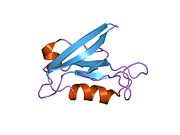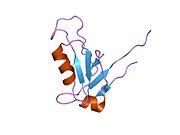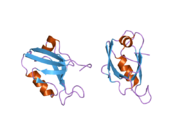DLG1
| View/Edit Human | View/Edit Mouse |
Discs large homolog 1 (DLG1), also known as synapse-associated protein 97 or SAP97, is a scaffold protein that in humans is encoded by the SAP97 gene.
SAP97 is a mammalian
Function
SAP97 is expressed throughout the body in epithelial cells, including the kidney and brain.
SAP97's function has been investigated by reducing its expression by
Clinical significance
Mutations in DLG1 are associated to Crohn's disease.[10]
Structure
SAP97's protein structure consists of an alternatively-spliced N-terminal domain, three PDZ domains, an SH3 domain, hook domain, I3 domain, and finally an inactive guanylate kinase (GK) domain. Each of these domains has specific interacting partners that help define SAP97's unique function.
The N-terminal of SAP97 can be alternatively spliced to contain a double-cysteine/palmitoylation site (α-isoform), or an L27 domain (β-isoform. The L27 domain is involved in SAP97
Each of SAP97's PDZ domains have different binding partners, including the AMPAR subunit GluR1
References
- ^ a b c GRCh38: Ensembl release 89: ENSG00000075711 – Ensembl, May 2017
- ^ a b c GRCm38: Ensembl release 89: ENSMUSG00000022770 – Ensembl, May 2017
- ^ "Human PubMed Reference:". National Center for Biotechnology Information, U.S. National Library of Medicine.
- ^ "Mouse PubMed Reference:". National Center for Biotechnology Information, U.S. National Library of Medicine.
- PMID 7891172.
- PMID 11567040.
- PMID 11238884.
- PMID 17172448.
- ^ PMID 12805297.
- PMID 24937328.
- PMID 11865057.
- PMID 12050163.
- PMID 15657400.
- PMID 9677374.[permanent dead link]
- PMID 12070168.
Further reading
- Humbert P, Russell S, Richardson H (Jun 2003). "Dlg, Scribble and Lgl in cell polarity, cell proliferation and cancer". BioEssays. 25 (6): 542–53. PMID 12766944.
- Mukherjee A, Varma SK, Natarajan K (Feb 1972). "Ankle joint instability in poliomyelitis". Indian Journal of Pediatrics. 39 (289): 37–8. S2CID 46659798.
- Kim E, Niethammer M, Rothschild A, Jan YN, Sheng M (Nov 1995). "Clustering of Shaker-type K+ channels by interaction with a family of membrane-associated guanylate kinases". Nature. 378 (6552): 85–8. S2CID 4362906.
- Lue RA, Marfatia SM, Branton D, Chishti AH (Oct 1994). "Cloning and characterization of hdlg: the human homologue of the Drosophila discs large tumor suppressor binds to protein 4.1". Proceedings of the National Academy of Sciences of the United States of America. 91 (21): 9818–22. PMID 7937897.
- Niethammer M, Kim E, Sheng M (Apr 1996). "Interaction between the C terminus of NMDA receptor subunits and multiple members of the PSD-95 family of membrane-associated guanylate kinases". The Journal of Neuroscience. 16 (7): 2157–63. PMID 8601796.
- Azim AC, Knoll JH, Marfatia SM, Peel DJ, Bryant PJ, Chishti AH (Dec 1995). "DLG1: chromosome location of the closest human homologue of the Drosophila discs large tumor suppressor gene". Genomics. 30 (3): 613–6. PMID 8825652.
- Lue RA, Brandin E, Chan EP, Branton D (Nov 1996). "Two independent domains of hDlg are sufficient for subcellular targeting: the PDZ1-2 conformational unit and an alternatively spliced domain". The Journal of Cell Biology. 135 (4): 1125–37. PMID 8922391.
- Takeuchi M, Hata Y, Hirao K, Toyoda A, Irie M, Takai Y (May 1997). "SAPAPs. A family of PSD-95/SAP90-associated proteins localized at postsynaptic density". The Journal of Biological Chemistry. 272 (18): 11943–51. PMID 9115257.
- Horio Y, Hibino H, Inanobe A, Yamada M, Ishii M, Tada Y, Satoh E, Hata Y, Takai Y, Kurachi Y (May 1997). "Clustering and enhanced activity of an inwardly rectifying potassium channel, Kir4.1, by an anchoring protein, PSD-95/SAP90". The Journal of Biological Chemistry. 272 (20): 12885–8. PMID 9148889.
- Lee SS, Weiss RS, Javier RT (Jun 1997). "Binding of human virus oncoproteins to hDlg/SAP97, a mammalian homolog of the Drosophila discs large tumor suppressor protein". Proceedings of the National Academy of Sciences of the United States of America. 94 (13): 6670–5. PMID 9192623.
- Satoh K, Yanai H, Senda T, Kohu K, Nakamura T, Okumura N, Matsumine A, Kobayashi S, Toyoshima K, Akiyama T (Jun 1997). "DAP-1, a novel protein that interacts with the guanylate kinase-like domains of hDLG and PSD-95". Genes to Cells. 2 (6): 415–24. S2CID 8934092.
- Hanada T, Lin L, Chandy KG, Oh SS, Chishti AH (Oct 1997). "Human homologue of the Drosophila discs large tumor suppressor binds to p56lck tyrosine kinase and Shaker type Kv1.3 potassium channel in T lymphocytes". The Journal of Biological Chemistry. 272 (43): 26899–904. PMID 9341123.
- Reuver SM, Garner CC (Apr 1998). "E-cadherin mediated cell adhesion recruits SAP97 into the cortical cytoskeleton". Journal of Cell Science. 111 (8): 1071–80. PMID 9512503.
- Leonard AS, Davare MA, Horne MC, Garner CC, Hell JW (Jul 1998). "SAP97 is associated with the alpha-amino-3-hydroxy-5-methylisoxazole-4-propionic acid receptor GluR1 subunit". The Journal of Biological Chemistry. 273 (31): 19518–24. PMID 9677374.
- Deguchi M, Hata Y, Takeuchi M, Ide N, Hirao K, Yao I, Irie M, Toyoda A, Takai Y (Oct 1998). "BEGAIN (brain-enriched guanylate kinase-associated protein), a novel neuronal PSD-95/SAP90-binding protein". The Journal of Biological Chemistry. 273 (41): 26269–72. PMID 9756850.
- Brenman JE, Topinka JR, Cooper EC, McGee AW, Rosen J, Milroy T, Ralston HJ, Bredt DS (Nov 1998). "Localization of postsynaptic density-93 to dendritic microtubules and interaction with microtubule-associated protein 1A". The Journal of Neuroscience. 18 (21): 8805–13. PMID 9786987.
- Bassand P, Bernard A, Rafiki A, Gayet D, Khrestchatisky M (Jun 1999). "Differential interaction of the tSXV motifs of the NR1 and NR2A NMDA receptor subunits with PSD-95 and SAP97". The European Journal of Neuroscience. 11 (6): 2031–43. S2CID 25611356.
- Firestein BL, Firestein BL, Brenman JE, Aoki C, Sanchez-Perez AM, El-Husseini AE, Bredt DS (Nov 1999). "Cypin: a cytosolic regulator of PSD-95 postsynaptic targeting". Neuron. 24 (3): 659–72. PMID 10595517.
- Hibino H, Inanobe A, Tanemoto M, Fujita A, Doi K, Kubo T, Hata Y, Takai Y, Kurachi Y (Jan 2000). "Anchoring proteins confer G protein sensitivity to an inward-rectifier K(+) channel through the GK domain". The EMBO Journal. 19 (1): 78–83. PMID 10619846.
- Adey NB, Huang L, Ormonde PA, Baumgard ML, Pero R, Byreddy DV, Tavtigian SV, Bartel PL (Jan 2000). "Threonine phosphorylation of the MMAC1/PTEN PDZ binding domain both inhibits and stimulates PDZ binding". Cancer Research. 60 (1): 35–7. PMID 10646847.













